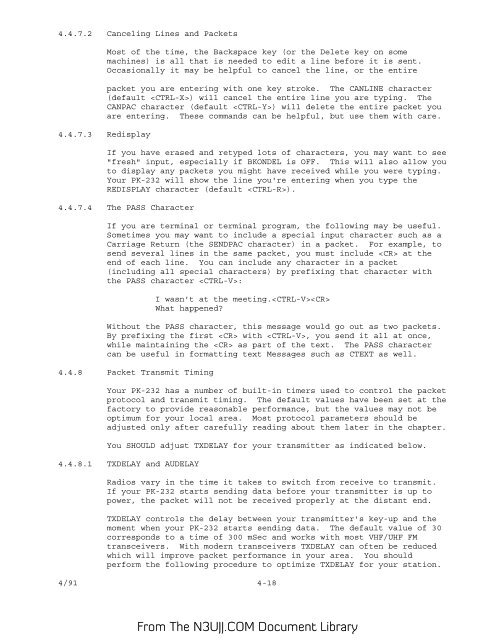You also want an ePaper? Increase the reach of your titles
YUMPU automatically turns print PDFs into web optimized ePapers that Google loves.
4.4.7.2 Canceling Lines and Packets<br />
4.4.7.3 Redisplay<br />
Most of the time, the Backspace key (or the Delete key on some<br />
machines) is all that is needed to edit a line before it is sent.<br />
Occasionally it may be helpful to cancel the line, or the entire<br />
packet you are entering with one key stroke. The CANLINE character<br />
(default ) will cancel the entire line you are typing. The<br />
CANPAC character (default ) will delete the entire packet you<br />
are entering. These commands can be helpful, but use them with care.<br />
If you have erased and retyped lots of characters, you may want to see<br />
"fresh" input, especially if BKONDEL is OFF. This will also allow you<br />
to display any packets you might have received while you were typing.<br />
Your <strong>PK</strong>-<strong>232</strong> will show the line you're entering when you type the<br />
REDISPLAY character (default ).<br />
4.4.7.4 The PASS Character<br />
If you are terminal or terminal program, the following may be useful.<br />
Sometimes you may want to include a special input character such as a<br />
Carriage Return (the SENDPAC character) in a packet. For example, to<br />
send several lines in the same packet, you must include at the<br />
end of each line. You can include any character in a packet<br />
(including all special characters) by prefixing that character with<br />
the PASS character :<br />
I wasn't at the meeting.<br />
What happened?<br />
Without the PASS character, this message would go out as two packets.<br />
By prefixing the first with , you send it all at once,<br />
while maintaining the as part of the text. The PASS character<br />
can be useful in formatting text Messages such as CTEXT as well.<br />
4.4.8 Packet Transmit Timing<br />
Your <strong>PK</strong>-<strong>232</strong> has a number of built-in timers used to control the packet<br />
protocol and transmit timing. The default values have been set at the<br />
factory to provide reasonable performance, but the values may not be<br />
optimum for your local area. Most protocol parameters should be<br />
adjusted only after carefully reading about them later in the chapter.<br />
You SHOULD adjust TXDELAY for your transmitter as indicated below.<br />
4.4.8.1 TXDELAY and AUDELAY<br />
Radios vary in the time it takes to switch from receive to transmit.<br />
If your <strong>PK</strong>-<strong>232</strong> starts sending data before your transmitter is up to<br />
power, the packet will not be received properly at the distant end.<br />
TXDELAY controls the delay between your transmitter's key-up and the<br />
moment when your <strong>PK</strong>-<strong>232</strong> starts sending data. The default value of 30<br />
corresponds to a time of 300 mSec and works with most VHF/UHF FM<br />
transceivers. With modern transceivers TXDELAY can often be reduced<br />
which will improve packet performance in your area. You should<br />
perform the following procedure to optimize TXDELAY for your station.<br />
4/91 4-18<br />
From The <strong>N3UJJ</strong>.COM Document Library
















